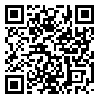Volume 21, Issue 1 (4-2018)
Hakim 2018, 21(1): 22-27 |
Back to browse issues page
Download citation:
BibTeX | RIS | EndNote | Medlars | ProCite | Reference Manager | RefWorks
Send citation to:



BibTeX | RIS | EndNote | Medlars | ProCite | Reference Manager | RefWorks
Send citation to:
Jafari R, Soleimani H, Arandian M H, Dahghan Manghabadi H, Hassanpoor Ashkzarei M M, Farahzadei M H, et al . Survey of Reservoirs and Frequency of Cutaneous Leishmaniasisin Abarkooh County, Yazd Province. Hakim 2018; 21 (1) :22-27
URL: http://hakim.tums.ac.ir/article-1-1861-en.html
URL: http://hakim.tums.ac.ir/article-1-1861-en.html
Reza Jafari 
 , Hassan Soleimani *
, Hassan Soleimani * 
 1, Mohammad Hossein Arandian
1, Mohammad Hossein Arandian 
 , Hossein Dahghan Manghabadi
, Hossein Dahghan Manghabadi 
 , Mohammad Mahdei Hassanpoor Ashkzarei
, Mohammad Mahdei Hassanpoor Ashkzarei 
 , Mohammad Hadei Farahzadei
, Mohammad Hadei Farahzadei 
 , Ali Reza Pormazar
, Ali Reza Pormazar 
 , Mohsan Zarnagharpanah
, Mohsan Zarnagharpanah 


 , Hassan Soleimani *
, Hassan Soleimani * 
 1, Mohammad Hossein Arandian
1, Mohammad Hossein Arandian 
 , Hossein Dahghan Manghabadi
, Hossein Dahghan Manghabadi 
 , Mohammad Mahdei Hassanpoor Ashkzarei
, Mohammad Mahdei Hassanpoor Ashkzarei 
 , Mohammad Hadei Farahzadei
, Mohammad Hadei Farahzadei 
 , Ali Reza Pormazar
, Ali Reza Pormazar 
 , Mohsan Zarnagharpanah
, Mohsan Zarnagharpanah 

1- , solimani47@yahoo.com
Abstract: (4127 Views)
Survey of Reservoirs and Frequency of Cutaneous Leishmaniasisin Abarkooh County, Yazd Province
Reza Jafari (MSc)1, Hassan Soleimani (MSc)2*, Mohammad Hossein Arandian1, Hossein Dahghan Manghabadi (BSc)3, Mohammad Mahdei Hassanpoor Ashkzarei (MD)3, Mohammad Hadei Farahzadei (MD)3, Ali Reza Pormazar (MD)4, Mohsan Zarnagharpanah31 Esfahan Health Research Station, National Institute of Health Research, Esfahan, Iran
2 Yazd Health Research Station, National Institute of Health Research, Yazd, Iran
3 Shahid Sadoughi University of Medical Sciences, County Abarkooh, Yazd, Iran
4 Provincial Health, Shahid Sadoughi University of Medical Sciences, Yazd, Iran
2 Yazd Health Research Station, National Institute of Health Research, Yazd, Iran
3 Shahid Sadoughi University of Medical Sciences, County Abarkooh, Yazd, Iran
4 Provincial Health, Shahid Sadoughi University of Medical Sciences, Yazd, Iran
Abstract
Introduction: Zoonotic cutaneous leishmaniasis (ZCL) is one of the most important parasitic diseases in Iran and common in rural districts of 17 of the 31 provinces of the country. In recent years, ZCL has become a serious and increasing public health problem in Yazd province. Following the epidemic of CL in the Abarkooh county, Yazd province, the purpose of this study was to determine the frequency of the disease and was carried out to determine the animal reservoir hosts and human infection in 2009 - 2010.
Methods: In order to investigate the frequency of the disease, at the end of autumn, 300 hundred households whose buildings were located near each other were visited and all members of the households were examined from each district, including 1130 people in Abarkooh city and the villages of Esfandabad and Haroni. Rodents were caught by 20 live traps biweekly from the summer and autumn of 2009. The rodents were identified morphologically and microscopic examination was performed.
Results: Eighteen (1.59%) cases had acute lesions of CL in the study area. Of these, 27.77% were male and 72.23% were female. A total of 353 cases had scars, of these 49% were male and 51% were female. The frequency of active lesions and scars among households with a total population of 1130 in three infected districts were calculated at 1.59 and 31.23, respectively. The frequency of the disease at the end of autumn was 328 per thousand. The most highly infected age group for acute lesions was under 4 years old (8.82%). Forty rodents (Rhombomys opimus) were collected and microscopic examination showed 35% Leishmania infiction rate.
Conclusions: Zoonotic cutaneous leishmaniasis (ZCL) is endemic in the Abarkooh county. The main reservoir host in this area is probably Rhombomys opimus. For rodent control, according to the guidelines of Centre of Communicable Diseases Management, public education and improving the environment is suggested.
Keywords: Leishmania Major; ZCL; Human Infection; Reservoir; Abarkooh; Yazd
Please cite this article as follows:
*Corresponding Author: Yazd Health Research Station, National Institute of Health Research, Yazd, Iran. Tel: +98-9139527258
E-mail: solimani47@yahoo.com
Type of Study: Original |
Subject:
General
Received: 2018/09/16 | Accepted: 2018/09/16 | Published: 2018/09/16
Received: 2018/09/16 | Accepted: 2018/09/16 | Published: 2018/09/16
Send email to the article author
| Rights and permissions | |
 |
This work is licensed under a Creative Commons Attribution-NonCommercial 4.0 International License. |



